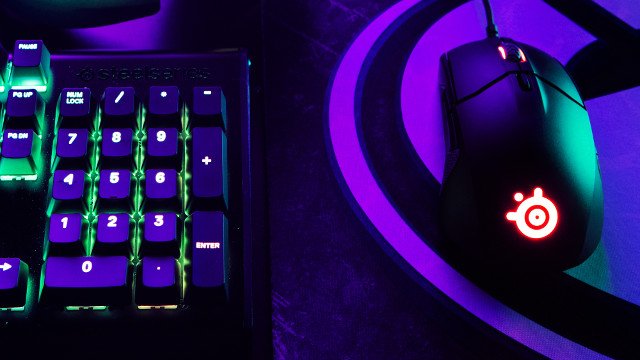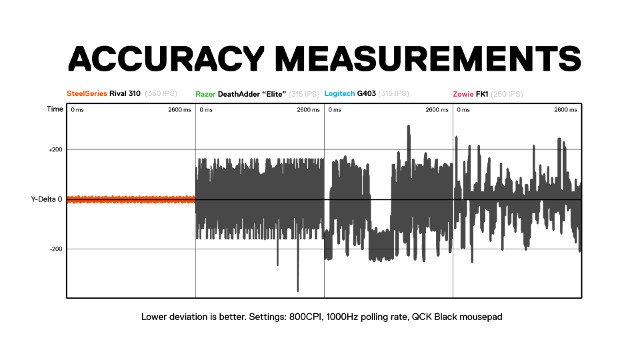It isn’t often that the gaming peripheral industry sees evolution. For many years, controllers, mice, and keyboards have largely provided the same operating features and mechanics, to a point where vanity perks like RGB lighting have recently become mainstream marketing points.
Though, SteelSeries has never been one to settle, and during the past couple years it has invested time and research into determining what the next big step will be. The result of this are two new mice: the Rival 310 and Sensei 310. These are familiar names for those who know the SteelSeries brand, but don’t let that fool you, these are two mice that for the time being have no substitute.
During the lead-up to release, I had a chance to speak to SteelSeries category manager for keyboards, mice, and surfaces Jason Christian about what is undoubtedly the company’s biggest hardware launch of 2017. As a PC gamer who uses the Rival 300 as a daily driver, this was an opportunity for me to get an idea of where the industry is headed, while simultaneously considering my first mouse upgrade in more than three years.
We began our discussion by talking about how the Rival 310 and Sensei 310 are building upon a strong foundation. The predecessors of these two mice, the Rival 300 and Sensei, have remained among the most popular with PC gamers and eSports professionals, regularly being featured on top 5 lists. Because of this, the idea wasn’t to completely reinvent the wheel, but rather improve upon the platform in meaningful ways that incorporate both player feedback and new technological evolution.
“We’re taking one step back and looking where we’re at in the market”, said Christian, “and currently there’s been a trend to move away from laser mice and gear more toward optical.”
As a result of this, the new mice will utilize an optical sensor that is similar to the Pixart PMW3310 that has been incorporated in most mainstream products. However, it has one significant advantage: accuracy.

The new PixArt TrueMove3 sensor is a cut above other solutions manufactured by the company with nearly 20 years of experience in the space. Its technical specs include 12,000 CPI, 350 IPS, and 50G acceleration, with features such as ultra low latency tracking, advanced jitter reduction, and reduced response time.
Although it has several selling points, the biggest line item is its tracking accuracy. “It starts with making sure the latency is as close to zero as possible”, said Christian, “that’s moving your mouse from point a to point b and making sure you aren’t deaccelerating or overaccelerating and missing your headshots.”
Although it has several selling points, the biggest line item is its tracking accuracy.
This is the first time in several years that PixArt has refined its technology, providing an opportunity to redefine what it means to have an accurate mouse.
In this instance, SteelSeries has exclusive rights to the technology thanks to a partnership between the two companies. “It’s only available to SteelSeries because we work closely with their team”, mentioned Christian, clearly expressing the company’s enthusiasm for what is a historical deal that’ll apply significant pressure to competing brands.
All of these are values that are admittedly challenging to demonstrate through text. SteelSeries has released a couple images that graph the accuracy and jitter of the new Rival 310 versus its main competition with visibly significant results. But really, its success will largely be dependent on word of mouth.

We then spoke about CPI for a moment, agreeing that the CPI arms race among mouse manufacturers has been slightly outrageous given most users don’t use anything beyond 3,200 CPI, especially in first-person shooters like Counter-Strike: Global Offensive where 400 to 800 CPI is considered preferable. Nonetheless, the TrueMove3 sensor will include 12,000 CPI, with 1-to-1 tracking supported up to 3,500 CPI, a 500 improvement over competing devices. With this in-mind, it’s clear that no compromises have been made, ensuring a confident step forward.
While the specs of the Rival 310 and Sensei 310 have been given the most attention, there are other notable changes. Among them are new build materials, including new side grip rubber that employs a soft silicone material that feels better in the hands while directly addressing concerns of durability in prior iterations. The upper body plastics are also different this time around, delivering a matte finish with a “little bit of roughness that’s largely fingerprint resistant”, a change from the smooth, glossier finish of the previous versions. The split-trigger design from the more expensive SteelSeries mice has also found its way into the lower priced Rival 310 and Sensei 310, offering the consistent trigger feel that eSports players favor.
…it’s clear that no compromises have been made, ensuring a confident step forward.
All this culminates in a significant debut in the peripheral industry that will have implications in the eSports scene. Evil Genius Dota 2 player Syed “SmaiL” Hassan has been an early tester of the Sensei 310, using it in recent LAN tournaments with positive results. “That’s what we need as players, gear to match our pace and be an extension of us. I’ve been winning LAN’s using a prototype of the Sensei 310 since early this year—now it’s my mouse, and, when I’m finished with it, it will have won millions”, said Hassan in a statement to the press.
The SteelSeries Rival 310 and Sensei 310 are now available through SteelSeries.com for $59.99. We will have reviews for both products in the coming weeks.







